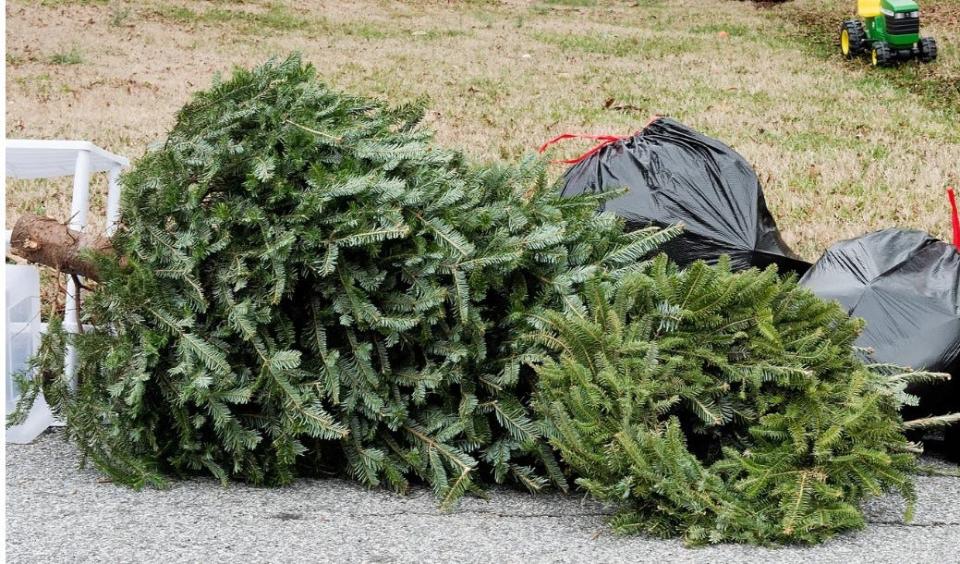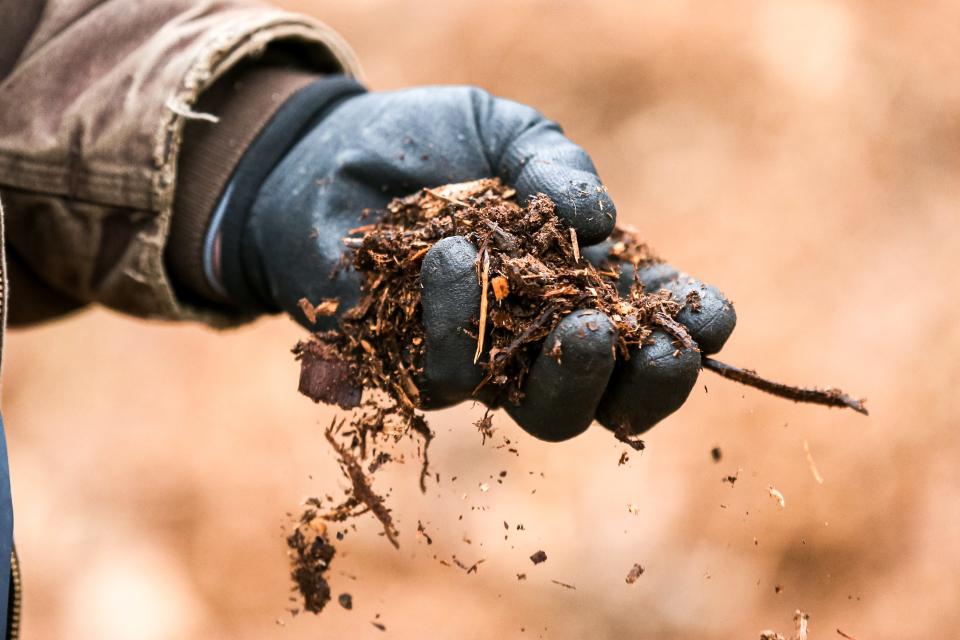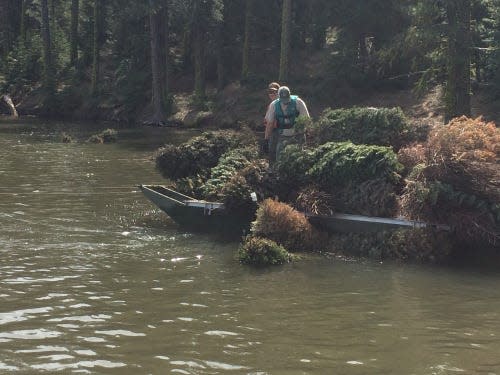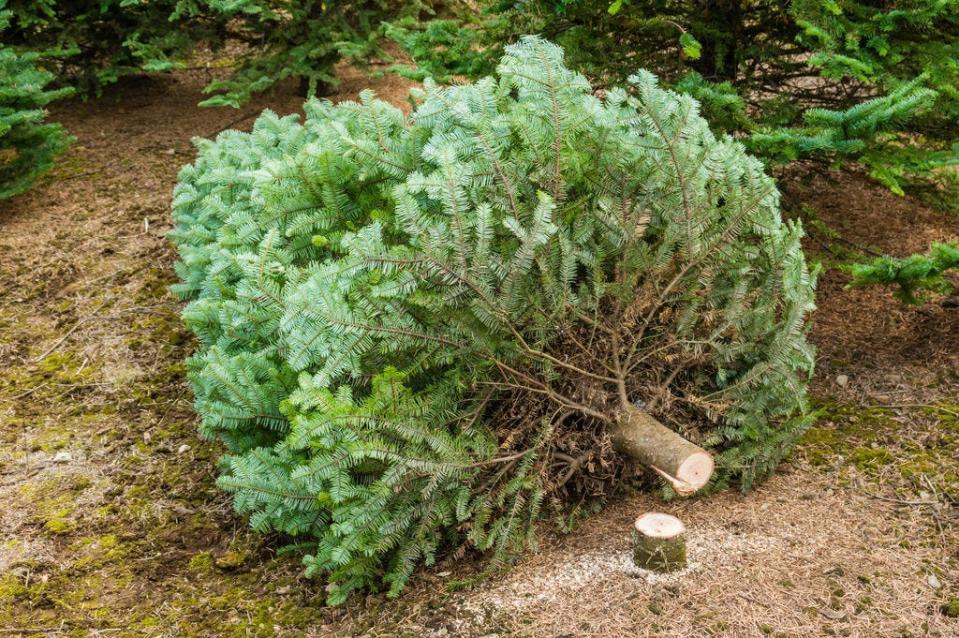Eat your Christmas tree? Yes, and 8 more ways to use your old tree besides kicking it to the curb
Christmas is over and the annual question arises: when do you toss the tree? Do you rush yours out of the house by New Year's, wait till after the first of the year, or do you put it off till all the needles fall off or you have to move it out of the way to set your clock an hour forward? (We don't judge.)
Whenever you make the call, if you have a live tree you'll need to decide what to do with it, and you have options besides hauling it out to the road. Here are the best ways to dispose of or repurpose organic holiday decorations in an environmentally friendly manner.

After the holidays: How to sustainably dispose of real Christmas trees
Recycle your old Christmas tree
Kicking it to the curb is still an option, just do it mindfully. Make sure your municipality has a "Chip-A-Tree" tree recycling program with curbside pickup or a drop-off station where your "Tannenbaum" will get mulched for use. Some locations may even offer the mulch for sale, or for free.
Make sure all decorations and tree stands have been removed and trees over 6 feet or so have been cut in half (check your local area for specifics). Flocked trees — those dusted with a synthetic material that looks like snow — can't be recycled.
If your local waste management company does not recycle trees, consider another option to avoid yours loading up in a landfill.
Mulch your Christmas tree yourself

If you have a garden, why give away perfectly organic material? Mulch has a variety of uses around homes and yards. You can put it around the base of trees or over gardens as an insulator, a weed controller and a source of moisture to help plants withstand cold temperatures and to help prevent soil erosion. Plus, it looks nice.
The needles can go right down just as they are. Pine needles dry quickly and decompose slowly, making them a good moisture-free mulch for ground-covering crops, according to This Old House. Cut the branches into small 1- or 2-inch pieces to use as mulch. Or you can run needleless branches one by one through a chipper-shredder. Use the pine-scented chips and sawdust you get out the other end as-is or leave the tree mulch in piles in the yard and wait until it eventually breaks down into nutrient-rich compost. If you already have a compost pile, just toss it on there.
A one to two-inch layer is great for garden beds, or go deeper if you want to make a chipped-wood garden path.
Use the rest of the tree around the garden
The trunk may be too big to break up or run through a chipper-shredder but you can dry it out for kindling and firewood, use it as a stake for flowers or beans, or cut it up into little 2-inch medallions to use as landscape edging in flower beds or along walkways. Branches make great plant stakes.
Christmas trees generally shouldn't be used in an indoor fireplace or wood stove as creosote can build up in the chimney and start a fire, but it's useful for outdoor fires or firepits.
Turn your Christmas tree into a bird or animal sanctuary
Winter is tough for birds. You can help them out by putting your tree in your yard — either on its side or in a heavy pot, with all decorations and hooks removed — and "decorating" it with food. Spread peanut butter on a pine cone and dip it in birdseed. Thread popcorn on a string. Got some apples, pears, orange slices or other fruit that's a little too old for you? The birds will love them. Cut 'em in half and hang them with string. Or just hang bird feeders on it. The birds get fed and you get a beautiful Disney scene in your yard.
If you don't want to put the whole tree out there then cut off some branches, cover them in butter, margarine or peanut butter, roll them in bird seed and hang those up instead.
Used trees also can be perfect for small animals seeking shelter from the cold. Just lie it down somewhere in your yard that isn't too exposed. While you may not think you want to offer a free place to stay for squirrels, mice and snakes, you'd probably rather they find someplace safe to stay that wasn't in your attic or garage.
When spring comes around, or what Floridians call spring, you can mulch it then.
Feed your Christmas tree to goats
If you have goats, your Christmas tree problems are over.
“They go ape over it,” said Alyssa Belanger, of the Slightly Off Course farm in Ashburnham, Massachusetts. “[Goats] get super bored in the winter because they’re foragers and there’s nothing to eat but their hay and grain. They love the holidays as much as we do.”
The pine needles contain nutrients, antioxidants and vitamin C, the sap acts as a natural dewormer, and they keep the animals entertained in otherwise boring winter months.
Eat your old Christmas tree yourself
In 2015, UK baker and cook Julia Georgallis decided to see if any parts of a Christmas tree were edible as part of a sustainability project, because why not, and she published a book of recipes in 2020, "How to Eat Your Christmas Tree."
Note that some trees (cedar, cypress) are poisonous to humans and mostly what she does is use different tree needles to add flavoring to foods, as opposed to chowing down on some bark. But "fir is really zesty and really grassy," she told Smithsonian Magazine, and "the spruce in the ice cream I make actually gives it a vanilla taste." She also discusses the use of tree flavors in jams, sauces and cocktails.
If you want to go farther, ecologist Artur Cisar-Erlach uses as much of the tree as he can in the recipes in his book, "The Flavor of Wood," with needle blends in pesto and bark in cookie dough.
Use your Christmas tree to provide structure and habitats for fish

Got a lake or pond on your property? Weigh it down and toss it in, or break it up and drop smaller, anchored bundles of branches. Make sure your tree is chemical-free and all decorations and hooks have been removed. You may need to check for town or city permission first.
When you sink trees into water bodies, you make the aquatic habitat more complex and provide places for aquatic species to flourish, which increases overall biodiversity. The branches offer sheltering habitats for fish and nursery areas for juvenile fish. They also provide a habitat for aquatic insects, something young fish need a lot of.
Cut your Christmas tree up for crafts or household use
There are a lot of uses for round discs of wood you don't have to pay for. Put them under your plant pots as risers to provide drainage and air circulation and to reduce pests. Make coasters, ornaments, trivets jewelry, or mixed-media artwork, just let any sap dry out first and varnish or coat them with polyurethane afterward.
If you really want to keep the Christmas feel going you can save some pine needles in little cloth bags as fragrant sachets. Use them in the backs of drawers, on shelves in your closet, or give them to friends.
Use Christmas trees to rebuild sand dunes
OK, this one isn't for the casual Christmas-tree-owner. But for years in Nueces County, Texas, the county collected Christmas trees to restore the dunes along Padre Island, arranging them in a specific pattern to catch and hold sand. Within about four months the trees were nearly covered in sand with beach grasses growing to anchor it all in place.
Cities in New York and New Jersey used the same method to rebuild dunes along their shorelines after getting hammered by Hurricane Sandy in 2012.
If you live at the beach, you can stake the tree at the edge of the dunes to help prevent tree erosion. Just make sure local laws are cool with it.
Bonus suggestion: Put your Christmas tree back in the ground after you're done with it

Can you replant your Christmas tree? Now we're talking recycling.
But your best bet is if you planned ahead and bought one with the root ball intact and well-watered. Your chances also improve the farther north in Florida you live. While we do have Christmas tree farms here, the Sunshine State isn't famous for its conifers.
You'll need to water it carefully while it's in the house, and take care when you plant it and afterward to help it transition back to the cold weather after your toasty living room. This Old House has some tips.
This article originally appeared on The Daytona Beach News-Journal: Christmas trees still have many recycled uses, even after the holiday

